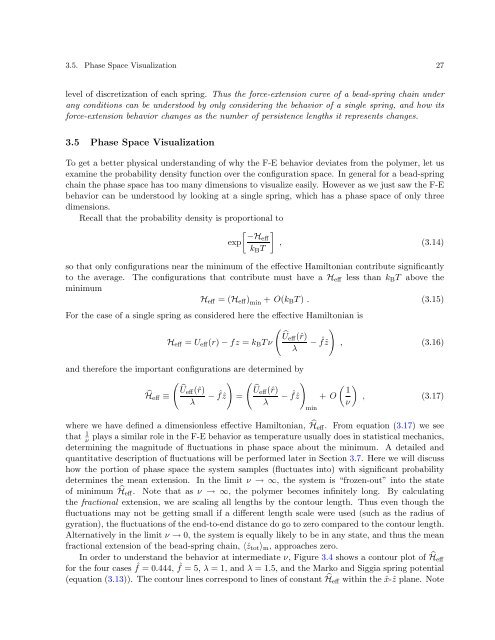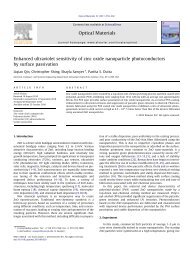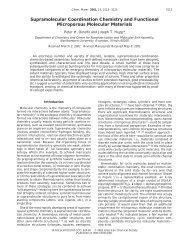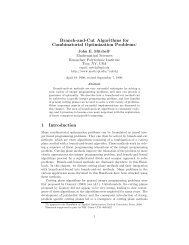Systematic development of coarse-grained polymer models Patrick ...
Systematic development of coarse-grained polymer models Patrick ...
Systematic development of coarse-grained polymer models Patrick ...
Create successful ePaper yourself
Turn your PDF publications into a flip-book with our unique Google optimized e-Paper software.
3.5. Phase Space Visualization 27<br />
level <strong>of</strong> discretization <strong>of</strong> each spring. Thus the force-extension curve <strong>of</strong> a bead-spring chain under<br />
any conditions can be understood by only considering the behavior <strong>of</strong> a single spring, and how its<br />
force-extension behavior changes as the number <strong>of</strong> persistence lengths it represents changes.<br />
3.5 Phase Space Visualization<br />
To get a better physical understanding <strong>of</strong> why the F-E behavior deviates from the <strong>polymer</strong>, let us<br />
examine the probability density function over the configuration space. In general for a bead-spring<br />
chain the phase space has too many dimensions to visualize easily. However as we just saw the F-E<br />
behavior can be understood by looking at a single spring, which has a phase space <strong>of</strong> only three<br />
dimensions.<br />
Recall that the probability density is proportional to<br />
<br />
−Heff<br />
exp , (3.14)<br />
kBT<br />
so that only configurations near the minimum <strong>of</strong> the effective Hamiltonian contribute significantly<br />
to the average. The configurations that contribute must have a Heff less than kBT above the<br />
minimum<br />
Heff =(Heff) min + O(kBT ) . (3.15)<br />
For the case <strong>of</strong> a single spring as considered here the effective Hamiltonian is<br />
<br />
Ueff(ˆr)<br />
Heff = Ueff(r) − fz = kBTν<br />
λ − ˆ <br />
f ˆz , (3.16)<br />
and therefore the important configurations are determined by<br />
<br />
Ueff(ˆr)<br />
Heff ≡<br />
λ − ˆ <br />
Ueff(ˆr)<br />
f ˆz =<br />
λ − ˆ <br />
f ˆz<br />
min<br />
+ O<br />
<br />
1<br />
ν<br />
, (3.17)<br />
where we have defined a dimensionless effective Hamiltonian, Heff. From equation (3.17) wesee<br />
that 1<br />
ν plays a similar role in the F-E behavior as temperature usually does in statistical mechanics,<br />
determining the magnitude <strong>of</strong> fluctuations in phase space about the minimum. A detailed and<br />
quantitative description <strong>of</strong> fluctuations will be performed later in Section 3.7. Here we will discuss<br />
how the portion <strong>of</strong> phase space the system samples (fluctuates into) with significant probability<br />
determines the mean extension. In the limit ν →∞, the system is “frozen-out” into the state<br />
<strong>of</strong> minimum Heff. Note that as ν →∞, the <strong>polymer</strong> becomes infinitely long. By calculating<br />
the fractional extension, we are scaling all lengths by the contour length. Thus even though the<br />
fluctuations may not be getting small if a different length scale were used (such as the radius <strong>of</strong><br />
gyration), the fluctuations <strong>of</strong> the end-to-end distance do go to zero compared to the contour length.<br />
Alternatively in the limit ν → 0, the system is equally likely to be in any state, and thus the mean<br />
fractional extension <strong>of</strong> the bead-spring chain, 〈ˆztot〉m, approaches zero.<br />
In order to understand the behavior at intermediate ν, Figure3.4 shows a contour plot <strong>of</strong> Heff<br />
for the four cases ˆ f =0.444, ˆ f =5,λ =1,andλ =1.5, and the Marko and Siggia spring potential<br />
(equation (3.13)). The contour lines correspond to lines <strong>of</strong> constant Heff within the ˆx-ˆz plane. Note







